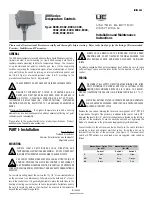
96
Enter
TP-LINK
at the DHCP Option 60 field.
Enter the IP addresses of the two ACs into DHCP Option 138 filed, therefore, the CAPs
in the network can find the two ACs.
Note:
•
Before configuring the external DHCP server, please disable the DHCP function of the AC to avoid CAPs
obtaining IP addresses abnormally.
• Please enable DHCP Relay function on the core switch to ensure that the DHCP packets can be
transmitted.
2 Configure the priority
There are several ACs in the network and they can manage all the CAPs normally. If you
want CAPs to be managed by a specified AC, set a higher priority for it. When a new
CAP requests to connect to an AC, the AC with higher priority will be connected first.
The higher value means higher priority.
In the above topology, the priority of AC1 is 150 and AC2 is 100. Therefore the AC
becomes the master controller of the CAPs and all CAPs will connect to AC1 first. AC2
is the standby controller.
3 Configure the standby AC
The standby AC comes into use when the master AC breaks down and cannot work
normally. In this situation, the CAPs will automatically accept the management of the
standby AC.
If you want CAPs to connect to another AC when the master AC malfunctions, please
enter the IP address of the standby AC into the peer address field. Therefore, the
master AC will deliver the IP address of the standby AC to CAPs when assigning IP
addresses. CAPs will be associated with master AC and standby AC at the same time.
When the master AC breaks down, the standby AC becomes the master AC.













































